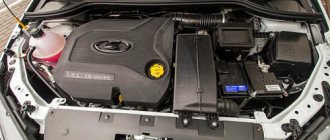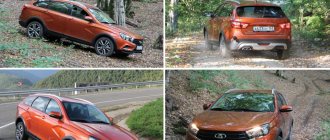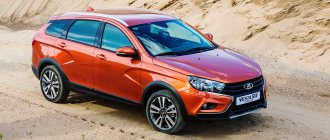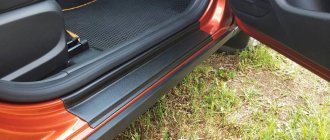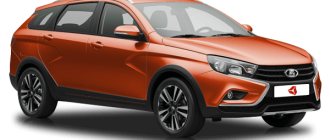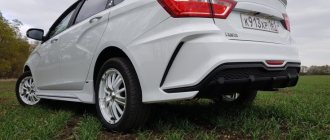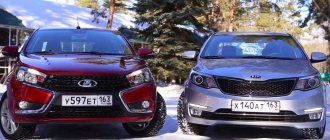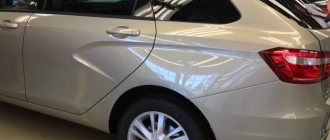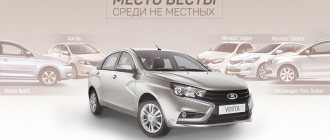Lada xRay and Vesta Cross are cars belonging to different classes. It should be noted that both models look quite presentable. Many experts consider them the best VAZ new products.
But the comparison of the X-ray and the Vesta cross from a technical point of view does not look entirely correct. In terms of its parameters, Vesta Cross resembles the station wagon of the same name, differing from it in ground clearance and plastic protection. As for the Lada xRay car, it is based on the Renault Sandero (read the article Lada x Ray or Renault Sandero).
After the release of the X Ray, Togliatti residents said that they would be able to sell about 16 thousand models in literally a year. But to this day, this car is a rather rare guest on domestic roads.
Main overall dimensions and appearance
Both models are made in the same stylish design with a pronounced letter X on many parts of the cars. The head optics and the front part of the body with the radiator grille are practically the same. Identical X-shaped stampings on the fenders and doors of cars attract the attention of others. The interior and ergonomics of the cabin have minor differences.
Comparison of Lada Vesta with Lada X Ray It is impossible to compare both of these models on the same scale. First of all, they are made in different body types, which means that a comparative analysis must be carried out taking into account this important design difference.
| Options | Lada X-Ray | Lada Vesta |
| Length/width/height (mm) | 4165/ 1764/ 1570 | 4410/ 1764/ 1497 |
| Wheelbase (mm) | 2592 | 2635 |
| Body/number of doors | Crossover/5 | Sedan/4 |
| Ground clearance (clearance) (mm) | 195 | 178 |
| Luggage compartment volume (l) | 361 | 480 |
| Curb/maximum weight (kg) | 1190/1650 | 1230/1670 |
| Fuel tank volume (l) | 50 | 55 |
The X Ray crossover, thanks to its significant ground clearance and short wheelbase, has advantages on roads with worse surfaces and on poor off-road conditions. In terms of dynamic characteristics, it loses to the more stocky and streamlined Lada Vesta sedan, whose center of gravity is lower and stability on the highway is much better than its competitor. If you compare the Lada Vesta in city traffic on the asphalt, in terms of maneuverability it is not much different from the X Ray.
Specifications
| Lada Xray Cross | Lada Vesta SW Cross | Chevrolet Niva | |
| Price | 914,000 rub. | 884,000 rub. | 776,000 rub. |
| Issued from | 2018 | 2017 | 2002 |
| Motor and gearbox | |||
| Engine | petrol / 1774 cm³ | petrol / 1774 cm³ | petrol / 1690 cm³ |
| Power | 122 hp | 122 hp | 80 hp |
| Transmission | mechanical / 5 steps | mechanical / 5 steps | mechanical / 5 steps |
| Drive unit | front | front | full |
| Acceleration to hundreds | 10.3 seconds | 11.2 seconds | 19 seconds |
| Maximum speed | 179 km/h | 180 km/h | 140 km/h |
| Fuel consumption | 9.3 / 5.8 / 7.1 l/100km | 10.7 / 6.4 / 7.9 l/100km | 13.2 / 8.4 / 10.2 l/100km |
| Body | |||
| Ground clearance | 215 mm | 203 mm | 220 mm |
| Dimensions (length × width × height) | 4165 / 1764 / 1645 mm | 4424 / 1785 / 1532 mm | 4056 / 1800 / 1690 mm |
| Trunk volume | 361 l | 480 l | 320 l |
| Fuel tank volume | 50 l | 55 l | 58 l |
| Vehicle weight | 1250 kg | 1280 kg | 1410 kg |
| Safety | |||
| Anti-lock braking system (ABS) | There is | There is | There is |
| Stabilization system (ESP) | There is | There is | unavailable |
| Number of airbags | 2 | 4 | 2 |
| Driver airbag | There is | There is | There is |
| Front passenger airbag | There is | There is | There is |
| Front side airbags | unavailable | There is | unavailable |
Ride and Handling
The comparison of the Lada Vesta with the Lada X Ray in terms of driving characteristics is the most interesting. The front suspension of both new products is independent, equipped with anti-roll bars. The rear wishbone semi-independent suspension with gas-filled shock absorbers is also unified for both cars. But the settings of the car's chassis are different.
The crossover in its design is designed for frequent trips to the countryside, and its suspension is tuned more rigidly to “swallow” potholes and bumps in off-road conditions. In the city of X, Ray is less comfortable due to the constant slight trembling from minor joints and defects of city roads.
Technical features of the cars The sedan is equipped with a softer suspension, which copes well with minor irregularities on the roads of the metropolis. But its design and suspension tuning are not designed to overcome serious obstacles.
In order to independently evaluate the driving advantages and handling of these cars and decide for yourself whether to buy a Lada Vesta or an X Ray, dealership centers offer a test drive. It is better to sign up for this service in advance, indicating a convenient date and time.
Prices for new AvtoVAZ products
Prices for Lada Vesta and Lada X Ray are displayed in detail on the official website of Lada cars. The significant difference in price from the basic configuration to its maximum performance is explained by the large number of options and generous equipment of the car. How much this or that modification will cost depends on the buyer’s preferences.
Basic equipment
Lada Vesta with the most modest Classic equipment and a base engine paired with a manual transmission will cost the buyer 545,000 rubles. The list of equipment already includes all the necessary safety systems for skidding and loss of control, two airbags and some pleasant little things for comfortable driving.
The cost of the X Ray in the minimum Optima configuration with the same engine and manual transmission starts from 600 thousand rubles. The equipment of the crossover is distinguished by the presence in the “base” of an installed audio system with speakers and modern functionality. In addition, X Ray is equipped with electric power steering, unlike Vesta’s electric power steering.
Maximum configuration
Prices for the new Vesta in Moscow with a “robot” and a more powerful engine start at 650,000 rubles for the average Comfort equipment. The maximum list of Luxe/Multimedia options will cost 735 thousand.
Differences between cars in the interior Similar equipment of a crossover in the average Luxe configuration will cost 760,000 rubles. The price of the top version Exclusive will be 830 thousand. The crossover has a more generous package, which includes:
- interior lighting;
- presence of an additional socket in the trunk;
- 17" alloy wheels;
- double luggage compartment floor;
- folding rear seats that create a flat surface for carrying additional luggage;
- leather trim of the gearshift knob and steering wheel;
- the presence of an additional box under the front passenger seat;
- original design of seats and interior Exclusive.
Answers (4)
If you need a large trunk, then Vesta SW Cross, if not, then x-ray
in Vesta the cross is larger inside and the trunk is larger, and the xray is taller and more compact, its ground clearance is higher - 215 mm versus 203 for Vesta) I would ride both first, before making a choice) Since to each his own)
Vesta trunk - 480 l, Xray - 361 l
Here only used for this money) From competitors X-Ray, Kia Soul or Suzuki Vitara New. For SW-cross Octavia A5 Scout
Plus basins in the price of a new car and warranties, and well, well. considering that they come with a gearbox and engine from a Priora, albeit modernized
If only the HR16DE engine and JR5 gearbox had remained together, as on the first Xrays, it would still be possible to think about it. But no )))))
There are no normal automatic machines, a robot from the last century with one clutch. It seems like they don’t even install them on Renault anymore. The rest have all given up long ago))
Conclusion
Despite the fact that these two representatives of the Tolyatti concern are assembled on the same platform and have the same units and components in their designs, they are still different. They differ in driving behavior, handling, some little details in equipment and much more. It is impossible to say unequivocally which of them is better, each is good in its own way. The final choice remains with the buyer, who will weigh the pros and cons and choose the best option for himself.
The main new product from Tolyatti this year is the Lada XRAY Cross. Let's look at the main advantages of the “off-road” Xray and find the main disadvantages in order to weigh the pros and cons of buying it.
LADA > XRAY
Body range of Vesta and X Ray
There is no need to talk about prestige in this case, since both models came off the assembly line of the same plant. And the buyers themselves still haven’t decided which one has more status. But the differences in terms of the body are much more significant.
Future station wagon from Lada Vesta.
So far, the Lada Vesta is sold as a sedan, but its significant expansion is being prepared - this will include a hatchback, a station wagon, a long-wheelbase version of the Lada Vesta Signature, and a pseudo-off-road Lada Vesta Cross. Therefore, soon new products from the Togliatti plant will fall like ripe apples!
Lada Vesta Cross car!
The Lada Xray acts exclusively as a hatchback (although many are persistently trying to present it as a crossover), and there can be no other option, excluding only the Lada XRAY Cross modification, which will soon appear on the market. However, apart from the plastic body kit, possible all-wheel drive and some other aspects, it will not differ in anything from the standard one.
Hatchback Lada X Ray Cross.
Ultimately, the choice of body depends on personal preference. If you need a sedan, then there is no other option other than Vesta. But when choosing a hatchback, you can either take the X-Ray, or wait for the production of its counterpart in the same body. There are no alternatives with a station wagon - just hope for the speedy release of the Vesta car.
Long-wheelbase modification of Lada Vesta Signature.
Lada Ride Select
Of course, the “off-road” version of Xray, like Vesta, does not have all-wheel drive. And it is unlikely to happen. But this modification still has some alternative. This is the Lada Ride Select system, which allows you to select one of five driving modes. It is also possible to disable the traction control system. There is also a sport mode, which sharpens the response to pressing the accelerator, and a “snow/mud and sand” mode, which not only changes the accelerator settings, but also allows a greater degree of slipping. We were able to fully test the latter mode in the Karakum sands. Of course, it will not replace all-wheel drive, but it will allow the car to move several tens of meters further than a regular XRAY.
Transmission and engine
Vesta Cross has only one uncontested 1.8 liter engine with 122 horsepower. At the limit of its power it produces 170 torque. And per hundred it consumes only 7 liters of gasoline. The car is equipped with a robotic transmission with ZF components.
The xRay model is available in two engine types. They are both petrol. The 1.6-liter engine produces 106 horsepower and 148 Nm of torque (more details here: What engine is on the Lada X ray).
The 1.8 liter engine produces 122 horsepower and contains 170 N/m of torque. Two transmission options: five-speed manual and robot (read more here: Gearbox x ray).
Chassis
In addition to many updates in the cabin and the appearance of the Lada Ride Select system, Xray Cross also underwent modernization of the chassis. The front suspension arms are similar to West's. It also comes with electric power steering. And, of course, disc brakes on all wheels. All this inevitably affected driving performance. The XRAY Cross rides on a winding road much nicer and clearer than the regular XRAY. Reactions to the steering wheel have become more accurate, and early drift of the front axle when overspeeding has disappeared. And an endless number of vibrations and shocks on uneven roads are no longer transmitted to the steering wheel.
The second minus is the cramped interior
Ixray also inherited a cramped rear row of seats from the co-platform Renault Stepway. There is not enough air for its inhabitants. Once a person of above average height is behind the wheel, he will no longer be able to sit comfortably. And the trunk, which holds 304 liters (according to ZR measurements), cannot be called gigantic by modern standards.
In a word, if the price does not scare you, and there is no urgent need for a super-spacious trunk, then the Lada XRAY Cross is a completely worthy choice even against the backdrop of numerous competitors.
- Finally, stylish cars have appeared in Russia, and in a decent car, everything should be beautiful: both the interior and the exterior. Well, the trunk is tidy, of course.
Cross course of Tolyatti engineering: Lada XRAY Cross, Lada Vesta SW Cross and Chevrolet Niva
We have already told you that XRAY Cross has become better than regular Xray - but by how much? Can it now beat Vesta SW Cross? And the third in this company will not be Cretocapturodaster, but the old Niva. The one that is Chevrolet. Have you forgotten that twenty years ago it began its life as a VAZ-2123? This is the last production all-wheel drive vehicle developed in Tolyatti. What could AvtoVAZ do then—and what has it come to now?
The statistics are more favorable to the Lada XRAY than the Autoreview experts: if in our tests the XRAY rarely deserved kind words, then in the sales ranking it has the title of the most popular hatchback on the Russian market. Who are you, Xray buyers? Is 18 centimeters of ground clearance and compact dimensions really all you need from a car? Do you not drive at all, but just endlessly park it on the sidewalks in cramped yards? Then we need to disband the expert group, because, apart from the Nissan 1.6 engine and a good smooth ride, we did not find anything decent in this car. And when such an engine was removed from the line...
A belt made of unpainted plastic and large wheels spaced wider corrected the inherent disproportion of the Xray - the Cross looks more harmonious
Inside AvtoVAZ, by the way, our skepticism was shared: the XRAY, created on the B0 platform, clearly required not restyling, but reengineering. Therefore, the Cross version is not so much a design product as an example of Tolyatti engineering initiative. Renault said: “We don’t need it,” and AvtoVAZ replied: “We already have it!”
The most noticeable difference in the interior is the optional orange trim, which our car didn't have. The best thing here is the convenient and intuitive multimedia system from Renault
Next to the usual Kalinas and Grants, the XRAY Cross seems like a lifted SUV: headlights at the level of the windshield, huge wheels, a wide track... But the interior, as before, does not support a major mood - you can add orange trim to this black cave for an additional fee, but it’s more comfortable she still won't. But the steering wheel now has reach adjustment, and the seats are now hybrid: the same cushion frame with new padding plus backrests from the foreign crossover Renault Kadjar. It’s a pity that the lumbar support is fixed, but sitting has become more comfortable. And the back of the passenger seat can be folded forward to expand the Xray’s not-so-impressive capabilities for transporting long items.
However, the main thing is that if you don’t want to drive an ordinary Xray, then you can already get along with Cross!
Now I am sure that the VAZ 1.8 engine (and the Cross version does not yet have another) has been cured of childhood illnesses. Almost. Dips and jerks are a thing of the past - for the second test in a row, we praise the good traction almost from idle and a pleasant mid-range. But what the hell is wrong with adjusting the gas pedal? Pressed - pause - went. You let go and you’re still going. These monstrous environmental delays in the city are incredibly annoying!
The full version is available only to subscribersSubscribe now
I'm already subscribed
